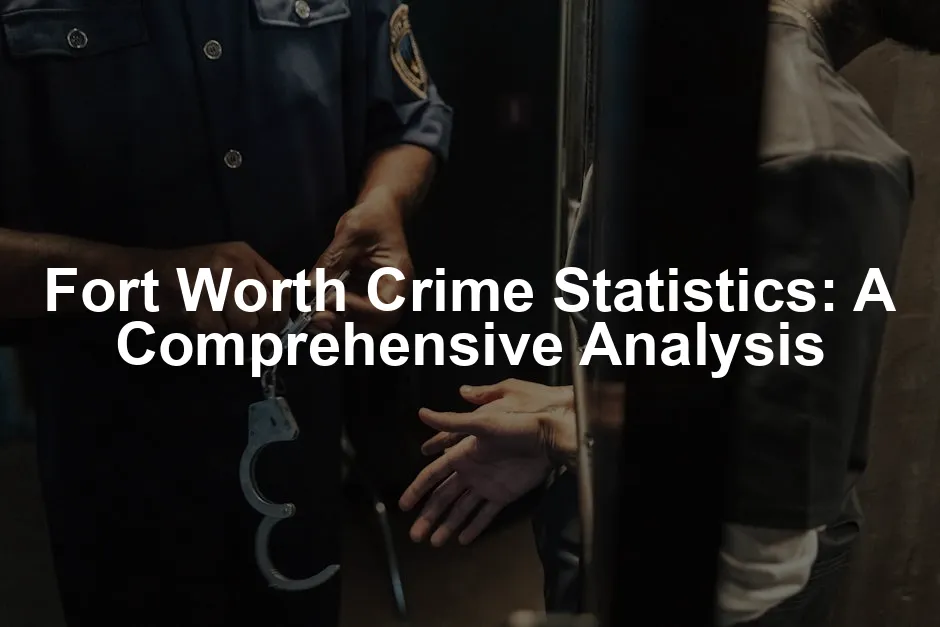Introduction
Crime statistics are crucial for understanding safety in Fort Worth, Texas. They reveal patterns, trends, and areas that might need more attention. For residents, these numbers are more than just digits; they’re indicators of safety and community well-being. For potential movers, knowing the crime rates can influence their decision on where to plant new roots. Policymakers rely on these statistics to craft effective strategies and allocate resources appropriately.
In Fort Worth, crime data is gathered from local law enforcement agencies. The statistics presented here reflect a snapshot of the crime landscape as of 2022, with updates made in October 2023. By analyzing these figures, we can better understand the city’s challenges and successes in maintaining safety.
Through this analysis, we will present a clearer picture of crime in Fort Worth, focusing on overall rates, types of offenses, and comparisons to state and national averages. Let’s get into the numbers that paint the city’s safety canvas.

Overview of Fort Worth Crime Statistics
What Are Crime Statistics?
Crime statistics are numerical data that describe the incidence of crimes in a specific area. They help identify trends and patterns, enabling communities to understand their safety levels. These statistics are vital for law enforcement, citizens, and researchers alike. They serve as a foundation for decisions that affect public safety and community resources.
Current Crime Snapshot
Fort Worth has an overall crime rate of 32 incidents per 1,000 residents. This means that for every 1,000 people, approximately 32 are involved in some form of crime. The chances of becoming a victim of crime in Fort Worth stand at 1 in 31. This statistic puts the reality of crime directly into perspective for residents and visitors alike.
Comparison to National and State Averages
When we compare these numbers to national and state averages, Fort Worth’s crime rates are notably higher. In fact, more than 91% of Texas communities boast lower crime rates than Fort Worth. This comparison underscores the city’s ongoing challenges with crime and safety, highlighting the need for continued vigilance and community action. Understanding these statistics is the first step toward fostering a safer Fort Worth.
To learn more about the specific crime rates and statistics in Fort Worth, visit our detailed analysis on Fort Worth Crime Statistics.

Main Crime Categories
Violent Crime Statistics
Definition of Violent Crimes
Violent crimes are serious offenses involving force or the threat of force. They include murder, rape, robbery, and assault. Each type of violent crime has its own unique characteristics and consequences. Understanding these distinctions is essential to grasp the overall safety of Fort Worth.
– Murder involves the unlawful killing of another person.
– Rape is a crime characterized by non-consensual sexual intercourse.
– Robbery combines theft with the use or threat of force.
– Assault involves causing physical harm or threatening to cause harm to another individual.
Current Statistics
Fort Worth has a violent crime rate of 5 per 1,000 residents. This statistic represents the total number of violent crimes relative to the city’s population. Breaking it down further, we observe specific rates for each type of violent crime:
– Murder: 0.10 per 1,000 residents
– Rape: 0.62 per 1,000 residents
– Robbery: 0.72 per 1,000 residents
– Assault: 3.54 per 1,000 residents
These statistics reveal a complex picture of safety in Fort Worth. While the murder rate is relatively low, the assault rate is significantly higher, indicating areas for concern.
Comparison to Other Cities
When we compare Fort Worth’s violent crime rate to other major Texas cities, it shows a mixed bag. For instance, Dallas has a much higher violent crime rate, at 778 per 100,000 people, while Houston’s rate stands at 1,141 per 100,000. In contrast, Fort Worth’s rate of 502 per 100,000 residents is lower than both. Austin also has a lower violent crime rate at 540 per 100,000.

This comparison places Fort Worth in a somewhat favorable light, particularly when considering its size. While it faces challenges, it appears to manage violent crime better than its larger neighbors.
Property Crime Statistics
Definition of Property Crimes
Property crimes involve the theft of property or damage to it. These crimes do not necessarily involve violence against individuals but can still impact the community’s sense of safety. Common types of property crimes include burglary, theft, and vehicle theft.
– Burglary involves unlawfully entering a building with the intent to commit a crime, typically theft.
– Theft refers to the unauthorized taking of someone else’s property.
– Motor Vehicle Theft specifically targets vehicles, whether cars, trucks, or motorcycles.
Current Statistics
Fort Worth’s property crime rate is notably higher than its violent crime rate, standing at 27 per 1,000 residents. Here’s the breakdown of specific property crime types:
– Burglary: 4.18 per 1,000 residents
– Theft: 19.38 per 1,000 residents
– Motor Vehicle Theft: 3.72 per 1,000 residents
These statistics suggest that theft, particularly ordinary larceny, is a prevalent issue in Fort Worth. The high rate of vehicle theft is particularly alarming and has garnered attention from both residents and law enforcement.
Trends and Observations
In recent years, Fort Worth has seen fluctuations in property crime rates. For example, motor vehicle theft has notably increased, making it one of the highest rates in the nation. This trend is concerning, as it indicates a need for improved vehicle security measures and community awareness.

Overall, while Fort Worth faces significant challenges with property crime, understanding these statistics can help residents take proactive measures to protect themselves and their belongings.
If you’re curious about the psychological aspects of crime, consider diving into The Sociopath Next Door by Martha Stout. This book explores the chilling reality of sociopathy and its implications on crime and safety in society.

Year-Over-Year Crime Trends
Fort Worth has experienced notable shifts in crime statistics over the past few years. In the latest report, the total crime rate increased by 2% compared to the previous year. This uptick might sound alarming, but context is key. Within this overarching trend, there’s a silver lining: violent crime has seen a remarkable decrease of 10%. Yes, you read that right! Fewer violent incidents mean safer streets for the city’s residents.
However, it’s not all sunshine and rainbows. Property crime, on the other hand, has taken a slightly different path. It has risen by 4.6%. This increase signals that while violent crime is on the decline, residents should remain vigilant about protecting their belongings.
Breaking these statistics down further provides greater insight. The decrease in violent crime can be attributed to effective policing strategies and community engagement initiatives. For example, local organizations have been working diligently with law enforcement to foster trust and collaboration, resulting in better reporting and prevention efforts.
On the flip side, the rise in property crime often ties back to broader economic factors. Issues like unemployment rates and housing costs can lead to an uptick in thefts and burglaries. Fort Worth, which boasts a vibrant economy, still faces challenges that can affect its crime landscape.

As residents navigate their daily lives, these statistics serve as a reminder to stay aware and proactive. Community programs aimed at crime prevention can play a significant role in turning the tide. For instance, neighborhood watch groups and increased community policing efforts can help deter property crimes while enhancing overall safety.
In summary, Fort Worth’s crime statistics tell a multifaceted story. While the city has made strides in reducing violent crime, the increase in property crime highlights the need for continued vigilance and community involvement. Understanding these trends helps residents make informed decisions about their safety and well-being while encouraging a collaborative approach to crime prevention.

Neighborhood Crime Rates
Overview of Crime by Neighborhood
Fort Worth is a city of diverse neighborhoods, each with its unique charm and, unfortunately, its crime rates. The variability in crime stats across these neighborhoods can be quite surprising. Some areas seem to have a crime rate that rivals a low-budget thriller, while others are as peaceful as a Sunday morning.
For instance, neighborhoods close to the city center often experience higher crime rates. These areas tend to have heavy foot traffic and commercial activity, which can contribute to a greater likelihood of theft and other property crimes. Meanwhile, residential neighborhoods further from the hustle and bustle often report fewer incidents, making them more appealing for families and those seeking a quieter lifestyle.
Understanding these neighborhood dynamics is essential for current residents and potential movers. Those looking for a home or apartment should consider not just the property but also the safety of the surrounding area. After all, living in Fort Worth shouldn’t feel like a scene out of a crime drama!

Safer Neighborhoods
Not all neighborhoods in Fort Worth are created equal when it comes to safety. Some areas shine brighter than others, offering residents a greater sense of security.
– Far Southwest: This neighborhood is known for its tight-knit community feel and lower crime rates. Families and individuals alike enjoy the peaceful environment, making it a sought-after spot for those prioritizing safety.
– Downtown: Surprisingly, despite being a bustling hub, Downtown Fort Worth has seen efforts to enhance safety. Local businesses and law enforcement have collaborated to create a secure atmosphere for residents and visitors.
– TCU-West Cliff: Home to the Texas Christian University community, this area benefits from active community engagement. The presence of students and families contributes to a safer, more vigilant neighborhood.
These neighborhoods demonstrate that Fort Worth has pockets of safety where residents can enjoy life without constantly glancing over their shoulders.

High Crime Areas
On the other side of the coin, some neighborhoods in Fort Worth struggle with above-average crime rates. Understanding these areas can help residents and potential movers make informed decisions.
– Southside: This vibrant neighborhood is known for its cultural richness, but it also faces challenges with higher crime rates. Residents are encouraged to stay alert and engage with community programs aimed at improving safety.
– Southeast: This area has garnered attention for its elevated property crime rates. Local initiatives are underway to address these challenges and foster a safer community.
– Western Hills-Ridglea: While this neighborhood offers beautiful homes and a suburban feel, it has also seen its share of crime. Community efforts are crucial in turning the tide and revitalizing safety in this area.

By keeping an eye on these neighborhoods, residents can better navigate Fort Worth’s crime landscape, making choices that align with their safety and lifestyle preferences.

Public Sentiment and Safety Perception
Understanding how residents feel about safety is crucial in assessing crime in Fort Worth. A recent survey by AreaVibes, featuring 204 respondents, revealed that public sentiment is quite mixed. About 43% of participants feel secure, claiming crime is nearly non-existent. However, a significant 57% feel a heightened sense of apprehension, indicating that the presence of crime looms large in their minds.
Further insights from Niche’s survey of 496 respondents show that 55% consider themselves “pretty safe.” Conversely, 15% acknowledge noticeable safety concerns. The percentage who feel “not safe” is alarmingly low at 2%, but it still signifies that fear exists within some pockets of the community. This psychological aspect of crime is essential; even a single crime can create ripples of fear that affect the quality of life for many.
When evaluating the effectiveness of law enforcement, the survey responses again reflect a divided opinion. According to Niche, 53% of respondents view the police as “very visible and very responsive.” However, 22% feel that while police presence is noted, their response times can be slow. This perception can impact community trust, which is vital for effective policing.
Statistics also indicate that while the overall crime rate stands at 32 incidents per 1,000 residents, perceptions about crime often outweigh the actual numbers. For instance, the chance of becoming a victim is about 1 in 31. This statistic might sound alarming, but it’s essential to consider that many residents feel safe despite the numbers.

The interplay between crime rates and quality of life is undeniable. Crime can impact property values, neighborhood cohesion, and mental well-being. If residents perceive their community as unsafe, they may limit their activities, leading to a decline in community engagement. Areas with lower crime rates typically exhibit stronger community ties and a more vibrant social atmosphere.
In summary, public sentiment regarding safety in Fort Worth is a mixed bag. While many residents feel secure, a notable portion harbors concerns that can influence their daily lives. Law enforcement’s visibility and responsiveness play significant roles in shaping these perceptions. Understanding these dynamics helps create a more comprehensive view of crime and safety in the city.

Causes of Crime Rates
Several factors converge to shape crime rates in Fort Worth, and understanding them is key to addressing safety concerns. Economic conditions can significantly influence crime trends. For instance, the current unemployment rate in Fort Worth hovers around 3.9%, which is lower than the national average of 4.7%. Lower unemployment typically correlates with reduced crime rates, as individuals are less likely to resort to crime when stable employment opportunities are available.
Social factors also play a pivotal role. Education levels, poverty rates, and community resources directly impact crime. Areas with higher educational attainment often show lower crime rates. Conversely, neighborhoods struggling with poverty can experience higher rates of crime, as economic desperation may lead individuals to engage in illegal activities.
Law enforcement presence is another crucial factor. Fort Worth has approximately 2.52 police officers per 1,000 residents, which is below the Texas average of 3.25. This reduction in police presence can strain community safety. A higher officer-to-resident ratio often leads to more effective crime prevention and quicker response times, both of which can deter potential criminal activity.
Housing costs can also influence crime rates. The average rent in Fort Worth is about $1,115, which is higher than the national average of $949. High housing costs can strain budgets, pushing some residents into economically precarious situations that could lead to crime. A correlation often exists between rising housing costs and increased property crime, as people may resort to theft or burglary out of necessity.

In summary, the interplay of economic, social, and law enforcement factors creates a complex backdrop for crime rates in Fort Worth. Understanding these causes is vital for devising effective strategies to enhance community safety. By addressing these underlying issues, Fort Worth can work toward a safer environment for all its residents.
If you’re interested in understanding the societal impacts of crime, you might want to read The New Jim Crow by Michelle Alexander. This book explores how mass incarceration affects communities, particularly those of color.

Methodology of Data Collection
Understanding crime statistics in Fort Worth starts with how data is collected and analyzed. Crime data comes from various sources, primarily local law enforcement agencies, which report incidents through established protocols. The FBI’s Uniform Crime Reporting (UCR) Program is a key player in this game. It aggregates data from over 18,000 law enforcement agencies across the nation. This ensures that the statistics reflect a broad range of incidents and provide a reliable snapshot of crime in the city.
Local police departments play a crucial role in this process. They record offenses, arrests, and other relevant data, which is then submitted to the FBI. This collaboration helps ensure accuracy and consistency in reporting. The Fort Worth Police Department, for instance, follows these guidelines meticulously, contributing to the comprehensive nature of the data.
However, it’s essential to recognize that no data collection method is perfect. There are limitations and potential biases in the data. For example, not all crimes are reported. Some victims may hesitate to come forward due to fear of retaliation or mistrust in law enforcement. This underreporting can skew the statistics, making the crime rate appear lower than it might be in reality.
Another consideration is the definitions of crimes themselves. Different jurisdictions may categorize offenses differently. What qualifies as “assault” in one area might not in another. This can lead to inconsistencies in how crime is recorded across different regions, including Fort Worth.
Moreover, the data is often analyzed using various statistical methods to identify trends and patterns. Analysts look for fluctuations over time, comparing current statistics with previous years. This helps to establish whether crime is increasing or decreasing and allows law enforcement to adapt their strategies accordingly.

In summary, while the methodology of collecting and analyzing crime data in Fort Worth is robust, it is not without its challenges. The combination of local law enforcement reporting to the FBI, alongside the recognition of potential biases in the data, contributes to a nuanced understanding of crime in the city.
Conclusion
In wrapping up our analysis of crime statistics in Fort Worth, a few key findings stand out. The overall crime rate stands at 32 per 1,000 residents, highlighting a significant issue for the community. While the violent crime rate has seen a decrease of 10% from the previous year, property crime has unfortunately risen by 4.6%. This suggests that while efforts to curb violent incidents are working, attention is still needed to address property crimes.
Understanding these statistics is vital for residents and policymakers alike. For individuals, staying informed about local crime rates can directly impact personal safety and well-being. It helps residents make informed decisions about their neighborhoods and encourages community engagement. For local governments, these insights can guide resource allocation and crime prevention strategies.
The importance of monitoring crime trends cannot be overstated. By keeping a watchful eye on data, community leaders can respond proactively to emerging issues. This ongoing vigilance allows them to implement effective crime-fighting strategies, ensuring the safety and security of Fort Worth residents.
Furthermore, fostering a strong relationship between law enforcement and the community is essential. Initiatives such as neighborhood watch programs and community policing can enhance trust and cooperation. When residents feel empowered to participate in crime prevention, they contribute to a safer environment for everyone.
In conclusion, while the crime statistics in Fort Worth present challenges, they also offer opportunities for improvement and community engagement. By staying informed and involved, residents can help shape the future of safety in their neighborhoods. It’s not just about numbers; it’s about creating a thriving, secure community for all.
What is the overall crime rate in Fort Worth?
Fort Worth has an overall crime rate of 32 incidents per 1,000 residents. This indicates a moderate level of crime compared to national averages, with a victimization chance of 1 in 31.
How does Fort Worth’s crime rate compare to other cities?
When compared to other large Texas cities, Fort Worth’s crime rate is higher than many. For instance, cities like El Paso report significantly lower crime rates, while Fort Worth is safer than Dallas, San Antonio, and Houston.
Which neighborhoods are the safest in Fort Worth?
Some of the safest neighborhoods in Fort Worth include: – Far Southwest: Known for its community feel and lower crime rates. – Downtown: Enhanced safety measures have made this area more secure. – TCU-West Cliff: The presence of families and students contributes to a safe environment.
What should residents do to stay safe in Fort Worth?
Residents can enhance their safety by: – Staying aware of their surroundings. – Participating in neighborhood watch programs. – Engaging with local law enforcement for community safety initiatives.
How can one access detailed crime data for Fort Worth?
Detailed crime reports can be accessed through the Fort Worth Police Department’s website or the FBI’s Crime Data Explorer. Additionally, resources like NeighborhoodScout provide comprehensive crime analytics.
Please let us know what you think about our content by leaving a comment down below!
Thank you for reading till here 🙂
All images from Pexels




